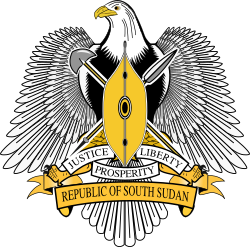Southern Sudan Legislative Assembly | |
|---|---|
 | |
| Type | |
| Type | |
| History | |
| Established | 2005 |
| Disbanded | 2011 |
| Preceded by | People's Regional Assembly |
| Succeeded by | Transitional National Legislature of South Sudan |
| Leadership | |
Speaker | James Wani Igga (last) |
| Structure | |
| Seats | 170 |
 | |
Political groups | Government (161) Opposition (9) |
| Elections | |
Mixed member majoritarian:
| |
Last election | 11–15 April 2010 |
| Meeting place | |
| Ministries Complex Juba Southern Sudan | |
| Website | |
| Government of Southern Sudan (permanent dead link) | |
The Southern Sudan Legislative Assembly was established in 2005 by the interim constitution of the Southern Sudan Autonomous Region. [1] Pending elections in 2010, all 170 members were appointed according to the following formula as per the Comprehensive Peace Agreement (CPA): [2]
Contents
- Latest elections
- President
- Legislative Assembly
- Members of the Legislative Assembly by party
- Speakers
- See also
- References
The Legislative Assembly met in Juba, the capital of Southern Sudan and Central Equatoria State. [3]
The last and arguably most historic sitting of the Assembly took place on 9 July 2011 at approximately 1.30 pm (Juba time) when the Declaration of Independence of South Sudan was read by the Rt. Hon. James Wani Igga, Speaker of the Southern Sudan Legislative Assembly. It was read at an open parliamentary session (sitting number 27-2011) of the Assembly in front of a large assembled audience at the Dr. John Garang Mausoleum in Juba, South Sudan. [4] [5]
Following the independence of the Republic of South Sudan, a new legislature was established in terms of the country's constitution. It together with the Council of States of South Sudan is the new National Legislature of South Sudan.

